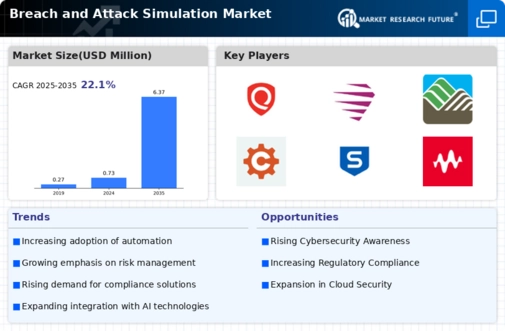Top Industry Leaders in the Breach Attack Simulation Market

Competitive Landscape of Breach and Attack Simulation Market: A Comprehensive Analysis
The Breach and Attack Simulation (BAS) market is experiencing explosive growth fueled by the relentless rise in cyberattacks and ever-increasing regulatory pressure on organizations to fortify their security posture. This dynamic landscape boasts a diverse range of players, each vying for a slice of the pie with distinct strategies and offerings.
Key Players:
-
Bit Dam
-
Qualys
-
Aujas
-
Rapid7
-
Cognito
-
Sophos
-
Keysight
-
Scythe
-
Attack IQ
-
ReliaQuest
-
Cymulate
-
XM Cyber
-
NopSec
-
Skybox Security
-
Foreseeti
-
FireMon
-
SafeBreach
-
Verodin
Strategies Adopted:
-
Scenario-Based Simulations: Players are moving beyond pre-defined attack vectors, offering customized simulations replicating real-world threat scenarios specific to industry verticals and attacker profiles.
-
Continuous Automation: Integrating BAS with Security Information and Event Management (SIEM) and Security Orchestration, Automation, and Response (SOAR) platforms automates incident response and mitigation, accelerating time to containment.
-
Cloud-Based Delivery: Cloud-based BAS offerings provide scalability, ease of deployment, and subscription-based pricing, making them attractive to smaller organizations and managed security service providers (MSSPs).
-
Threat Intelligence Integration: Embedding real-time threat intelligence feeds into BAS platforms keeps simulations current and relevant, ensuring organizations are prepared for the latest attack vectors.
Factors for Market Share Analysis:
-
Solution Breadth and Depth: The comprehensive nature of attack vectors covered, the sophistication of attack simulation, and the level of reporting and remediation guidance provided are crucial factors.
-
Deployment Flexibility: Options for on-premise, cloud, or hybrid deployment cater to diverse organizational needs and infrastructure constraints.
-
Ease of Use and Integration: Intuitive interfaces, seamless integration with existing security tools, and minimal training requirements are key for widespread adoption.
-
Customer Support and Services: Responsive technical support, training programs, and post-implementation consulting services add significant value for customers.
New and Emerging Companies:
The BAS market is constantly evolving, with startups entering the scene with disruptive technologies and approaches. Some noteworthy names include:
-
Torq: Utilizes artificial intelligence (AI) and machine learning (ML) to automate attack path discovery and prioritize vulnerabilities.
-
Siemplify: Integrates BAS with their SOAR platform, offering streamlined incident response workflows.
-
Vectra AI: Leverages AI-powered network detection and response (NDR) to provide real-time insights into ongoing attack simulations.
Current Company Investment Trends:
-
Cloud Infrastructure: Expanding cloud-based delivery options through platform development and strategic partnerships with cloud providers.
-
AI and ML Integration: Leveraging AI and ML for automated attack path discovery, vulnerability prioritization, and even adaptive attack simulation capabilities.
-
Partner Ecosystems: Building strong partnerships with technology vendors, MSSPs, and system integrators to enhance reach and market penetration.
-
Vertical Market Specialization: Tailoring solutions and marketing efforts to address the specific needs of industries like healthcare, finance, and critical infrastructure.
Latest Company Updates:
-
January 9, 2024: Palo Alto Networks acquires Demisto, a leading security orchestration, automation, and response (SOAR) platform. The move aims to integrate Demisto's SOAR capabilities with Palo Alto's Cortex XDR platform, including BAS functionality.
-
December 15, 2023: Mandiant releases a report on the rise of "living off the land" attacks, where attackers exploit legitimate tools and applications already present on victim systems. This highlights the importance of continuous testing and validation of security controls through BAS.
-
November 28, 2023: CyberArk launches a new BAS solution specifically designed for cloud environments. The platform helps organizations identify and address security risks associated with cloud infrastructure and workloads.









